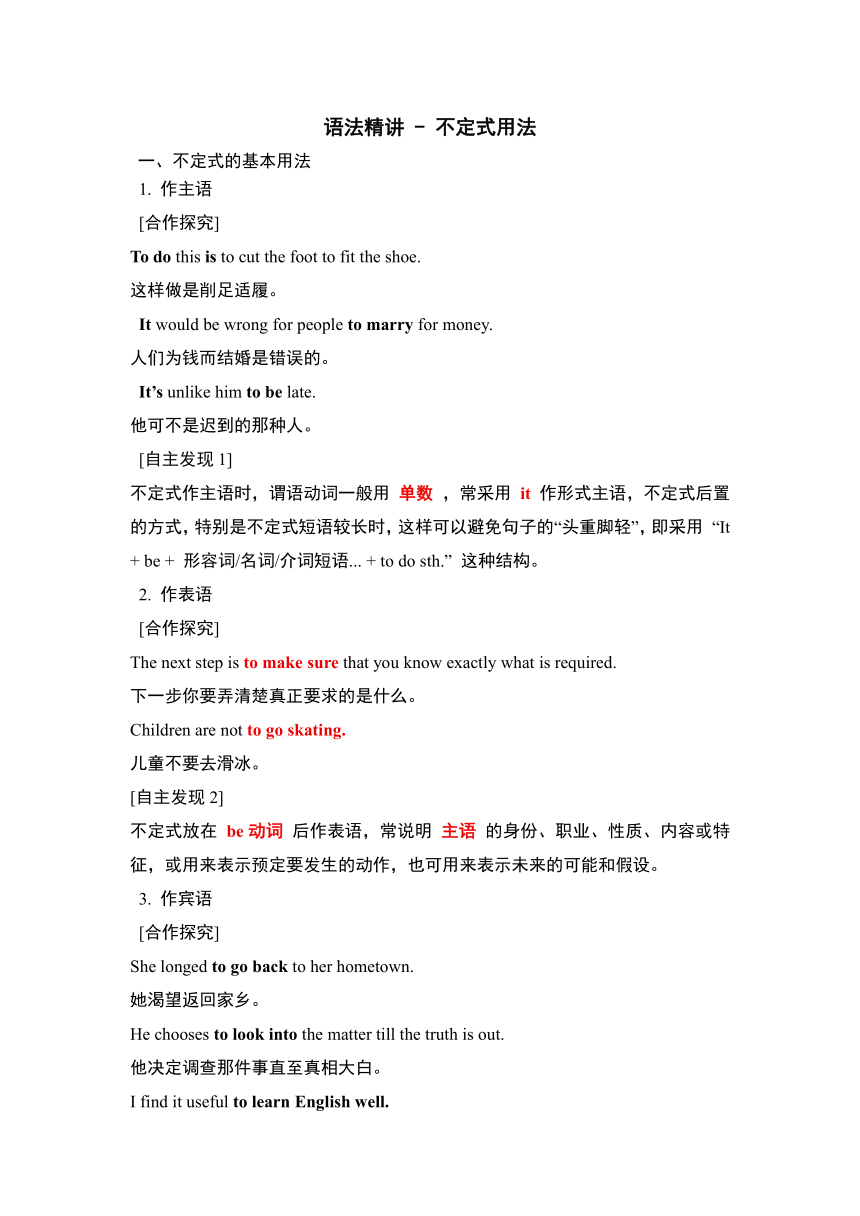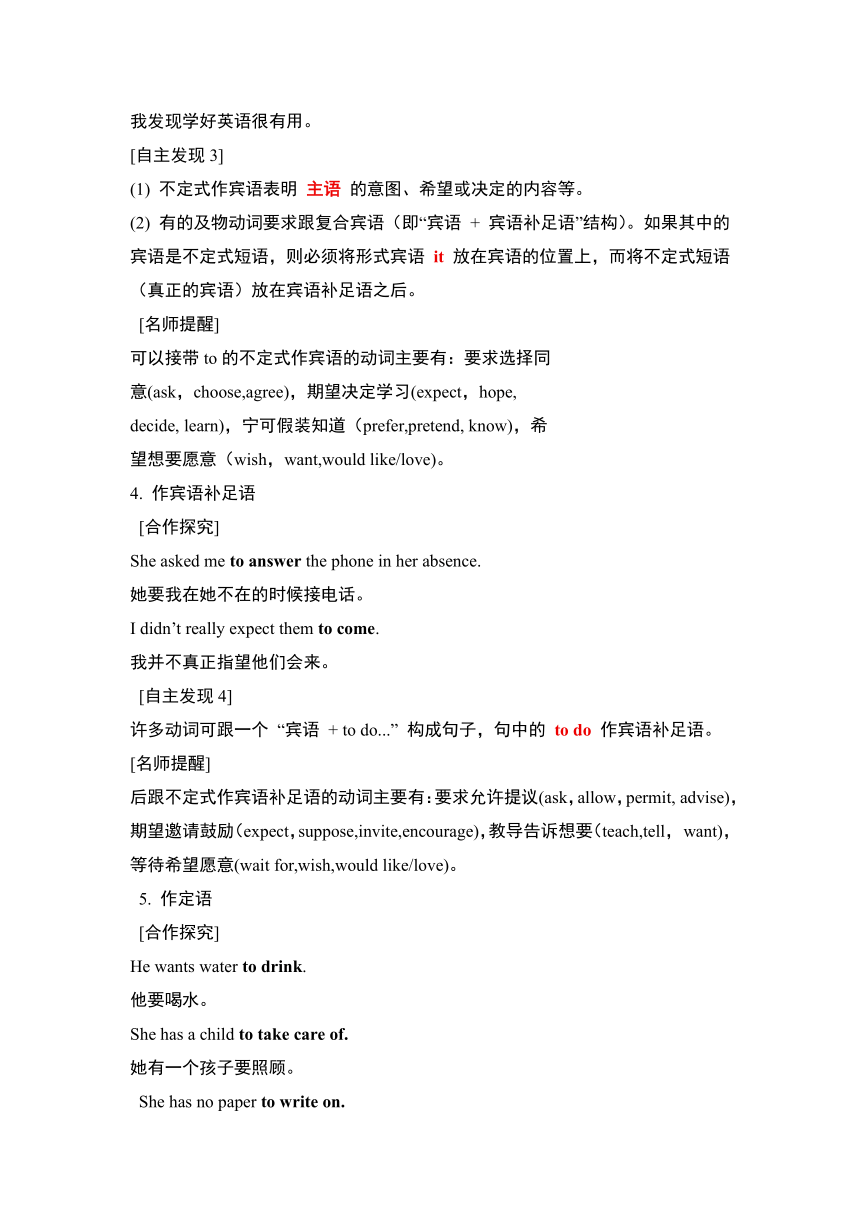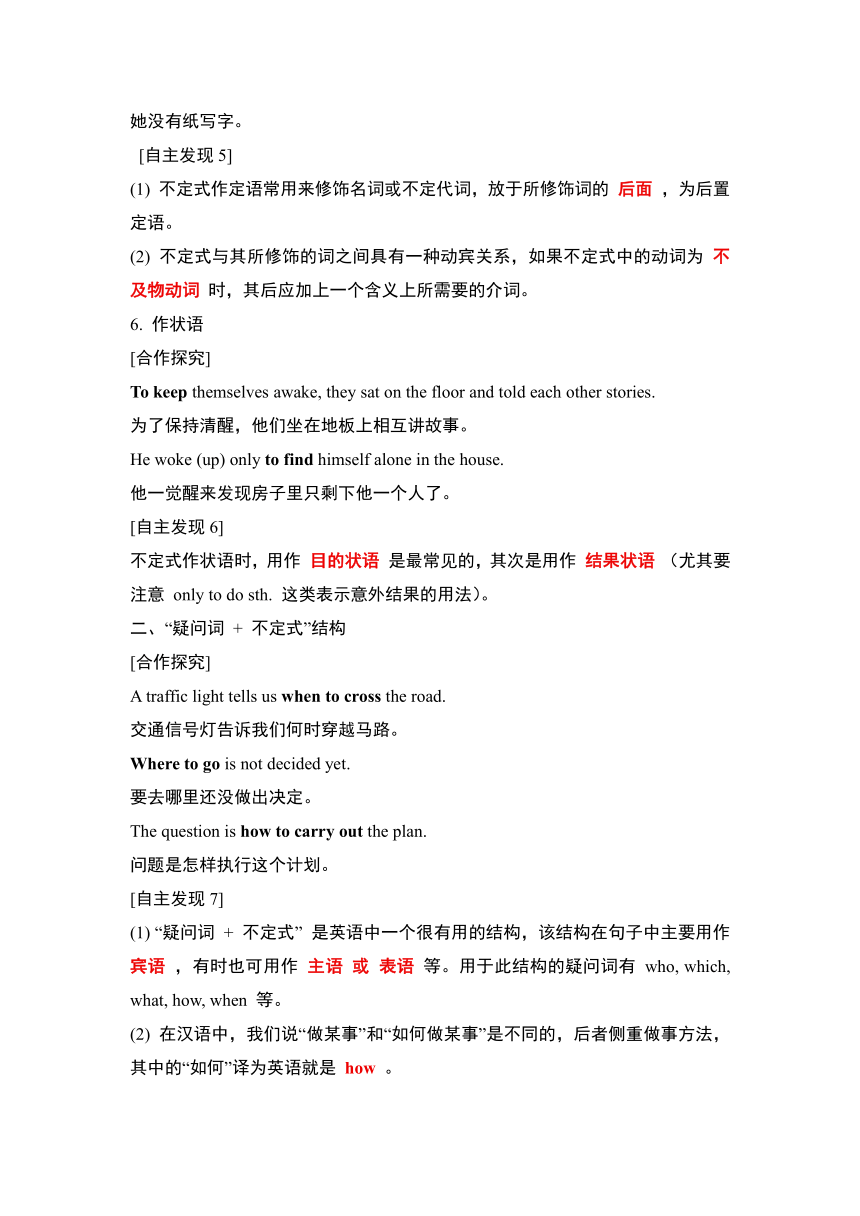Unit1 Life Choices 语法不定式导学案(含答案)---2025-2026学年高中英语北师大版(2019)必修第一册
文档属性
| 名称 | Unit1 Life Choices 语法不定式导学案(含答案)---2025-2026学年高中英语北师大版(2019)必修第一册 |  | |
| 格式 | docx | ||
| 文件大小 | 20.8KB | ||
| 资源类型 | 教案 | ||
| 版本资源 | 北师大版(2019) | ||
| 科目 | 英语 | ||
| 更新时间 | 2025-07-23 20:32:00 | ||
图片预览



文档简介
语法精讲 - 不定式用法
一、不定式的基本用法
1. 作主语
[合作探究]
To do this is to cut the foot to fit the shoe.
这样做是削足适履。
It would be wrong for people to marry for money.
人们为钱而结婚是错误的。
It’s unlike him to be late.
他可不是迟到的那种人。
[自主发现1]
不定式作主语时,谓语动词一般用 单数 ,常采用 it 作形式主语,不定式后置的方式,特别是不定式短语较长时,这样可以避免句子的“头重脚轻”,即采用 “It + be + 形容词/名词/介词短语... + to do sth.” 这种结构。
2. 作表语
[合作探究]
The next step is to make sure that you know exactly what is required.
下一步你要弄清楚真正要求的是什么。
Children are not to go skating.
儿童不要去滑冰。
[自主发现2]
不定式放在 be动词 后作表语,常说明 主语 的身份、职业、性质、内容或特征,或用来表示预定要发生的动作,也可用来表示未来的可能和假设。
3. 作宾语
[合作探究]
She longed to go back to her hometown.
她渴望返回家乡。
He chooses to look into the matter till the truth is out.
他决定调查那件事直至真相大白。
I find it useful to learn English well.
我发现学好英语很有用。
[自主发现3]
(1) 不定式作宾语表明 主语 的意图、希望或决定的内容等。
(2) 有的及物动词要求跟复合宾语(即“宾语 + 宾语补足语”结构)。如果其中的宾语是不定式短语,则必须将形式宾语 it 放在宾语的位置上,而将不定式短语(真正的宾语)放在宾语补足语之后。
[名师提醒]
可以接带to的不定式作宾语的动词主要有:要求选择同
意(ask,choose,agree),期望决定学习(expect,hope,
decide, learn),宁可假装知道(prefer,pretend, know),希
望想要愿意(wish,want,would like/love)。
4. 作宾语补足语
[合作探究]
She asked me to answer the phone in her absence.
她要我在她不在的时候接电话。
I didn’t really expect them to come.
我并不真正指望他们会来。
[自主发现4]
许多动词可跟一个 “宾语 + to do...” 构成句子,句中的 to do 作宾语补足语。
[名师提醒]
后跟不定式作宾语补足语的动词主要有:要求允许提议(ask,allow,permit, advise),期望邀请鼓励(expect,suppose,invite,encourage),教导告诉想要(teach,tell, want),等待希望愿意(wait for,wish,would like/love)。
5. 作定语
[合作探究]
He wants water to drink.
他要喝水。
She has a child to take care of.
她有一个孩子要照顾。
She has no paper to write on.
她没有纸写字。
[自主发现5]
(1) 不定式作定语常用来修饰名词或不定代词,放于所修饰词的 后面 ,为后置定语。
(2) 不定式与其所修饰的词之间具有一种动宾关系,如果不定式中的动词为 不及物动词 时,其后应加上一个含义上所需要的介词。
6. 作状语
[合作探究]
To keep themselves awake, they sat on the floor and told each other stories.
为了保持清醒,他们坐在地板上相互讲故事。
He woke (up) only to find himself alone in the house.
他一觉醒来发现房子里只剩下他一个人了。
[自主发现6]
不定式作状语时,用作 目的状语 是最常见的,其次是用作 结果状语 (尤其要注意 only to do sth. 这类表示意外结果的用法)。
二、“疑问词 + 不定式”结构
[合作探究]
A traffic light tells us when to cross the road.
交通信号灯告诉我们何时穿越马路。
Where to go is not decided yet.
要去哪里还没做出决定。
The question is how to carry out the plan.
问题是怎样执行这个计划。
[自主发现7]
(1) “疑问词 + 不定式” 是英语中一个很有用的结构,该结构在句子中主要用作 宾语 ,有时也可用作 主语 或 表语 等。用于此结构的疑问词有 who, which, what, how, when 等。
(2) 在汉语中,我们说“做某事”和“如何做某事”是不同的,后者侧重做事方法,其中的“如何”译为英语就是 how 。
三、不定式的否定式
[合作探究]
The doctor advised me not to smoke.
医生劝我不要抽烟。
Father warned me never to drive after drinking.
父亲警告我不要酒后开车。
[自主发现8]
将否定词 not 或 never 置于不定式之前,即构成 not to do 或 never to do 的形式。
四、不定式的特殊用法
1. 不定式符号 to 的省略:
(1) 跟在感官动词和使役动词后面作宾语补足语。常见的两类词有:一感(feel),二听(listen to, hear),三让(let, have, make),四看(see, look at, watch, observe),半帮助(help)。
He let his daughter practice playing the piano every day.
他每天都让他的女儿练钢琴。
(2) 在 but, other than 后面作宾语,若介词前有行为动词 do 的某种形式,那么不定式符号 to 省略。
We can do nothing but wait the doctor.
除了等医生我们无事可做。
(3) 在 cannot but, cannot help but, cannot choose but, had better, would rather... than 等后作宾语的不定式,通常省略 to。
We cannot help but admire his courage.
我们不得不钦佩他的勇气。
2. it 充当形式主语,to do 作真正的主语的常见句式:
(1) It is easy/difficult/hard/important/right/wrong/possible/necessary/foolish/kind... to do...
It is very easy to solve the problem.
解决这个问题很容易。
(2) It is a pleasure/pity/pleasant thing/an honor... to do...
It is a pleasure to work with you.
和你一起工作真是件乐事。
(3) It takes sb. some time/money to do...
It took me two hours to finish the homework yesterday.
昨天完成家庭作业花了我两个小时。
3. it 充当形式宾语,to do 作真正的宾语的句式:
在句式“主语 + v. + it + adj./n. + to do”中,it 为形式宾语,to do 为真正的宾语,能用于此句式的动词有 believe, consider, feel, find, make, suppose, think 等。
I think it very useful to learn a foreign language.
我认为学一门外语很有用。
4. doing 与 to do 作结果状语的区别:
doing 表示顺其自然的结果,而 to do 表示出乎意料的结果。
It hasn’t rained for several months, leaving the crops die.
好几个月没下雨了,结果庄稼都死了。
He hurried to the supermarket, only to find it was locked.
他匆匆忙忙地去了超市,却发现门锁着。
五、实践应用
Ⅰ. 单句语法填空
1. My mother taught me ________ to play the piano.
2. Visitors are requested ________ to touch the exhibits.
3. I do not know ________ to do and where to go.
4. The best way ________ (improve) your English is ________ (join) an English club.
5. I’m beginning ________ (understand) my Chinese roots, and who I am.
6. It’s also a good idea for parents to allow teenagers ________ (study) in groups during the evening.
Ⅱ. 完成句子
1. She got up early ________.
她起得很早,为的就是赶上早班车2. I strongly advise you ____________.
我强烈建议你不要这样做。
3. I arrived at the shop only ____________ at home.
我到商店却发现钱全落在家里了。
4. He is not the kind of man ____________.
他不可能是做这种事的人。
5. It’s a shame ____________.
那样说话是可耻的。
6. The purpose of education is ____________ in children.
教育的目的是培养儿童良好的品格。
答案:
Ⅰ. 单句语法填空
1. how(“疑问词 + 不定式” 作宾语,表 “如何弹钢琴” )
2. not(be requested not to do sth. 被要求不要做某事 )
3. what(“疑问词 + 不定式” 作宾语,表 “做什么” )
4. to improve; to join(the way to do sth. 做某事的方法;不定式作表语,说明 way 内容 )
5. to understand(begin to do sth. 开始做某事 )
6. to study(allow sb. to do sth. 允许某人做某事 )
Ⅱ. 完成句子
1. to catch the early bus(不定式作目的状语,表 “早起的目的” )
2. not to do so(advise sb. not to do sth. 建议某人不要做某事 )
3. to find I’d left all my money(only to do 表意外结果;“钱落在家里” 是到达商店前的动作,用过去完成时 )
4. to do such things(不定式作后置定语,修饰 man ,表 “做这种事的人” )
5. to speak like that(It’s a shame to do sth. 做某事是可耻的 )
6. to develop a good character(不定式作表语,说明 purpose 内容 )
一、不定式的基本用法
1. 作主语
[合作探究]
To do this is to cut the foot to fit the shoe.
这样做是削足适履。
It would be wrong for people to marry for money.
人们为钱而结婚是错误的。
It’s unlike him to be late.
他可不是迟到的那种人。
[自主发现1]
不定式作主语时,谓语动词一般用 单数 ,常采用 it 作形式主语,不定式后置的方式,特别是不定式短语较长时,这样可以避免句子的“头重脚轻”,即采用 “It + be + 形容词/名词/介词短语... + to do sth.” 这种结构。
2. 作表语
[合作探究]
The next step is to make sure that you know exactly what is required.
下一步你要弄清楚真正要求的是什么。
Children are not to go skating.
儿童不要去滑冰。
[自主发现2]
不定式放在 be动词 后作表语,常说明 主语 的身份、职业、性质、内容或特征,或用来表示预定要发生的动作,也可用来表示未来的可能和假设。
3. 作宾语
[合作探究]
She longed to go back to her hometown.
她渴望返回家乡。
He chooses to look into the matter till the truth is out.
他决定调查那件事直至真相大白。
I find it useful to learn English well.
我发现学好英语很有用。
[自主发现3]
(1) 不定式作宾语表明 主语 的意图、希望或决定的内容等。
(2) 有的及物动词要求跟复合宾语(即“宾语 + 宾语补足语”结构)。如果其中的宾语是不定式短语,则必须将形式宾语 it 放在宾语的位置上,而将不定式短语(真正的宾语)放在宾语补足语之后。
[名师提醒]
可以接带to的不定式作宾语的动词主要有:要求选择同
意(ask,choose,agree),期望决定学习(expect,hope,
decide, learn),宁可假装知道(prefer,pretend, know),希
望想要愿意(wish,want,would like/love)。
4. 作宾语补足语
[合作探究]
She asked me to answer the phone in her absence.
她要我在她不在的时候接电话。
I didn’t really expect them to come.
我并不真正指望他们会来。
[自主发现4]
许多动词可跟一个 “宾语 + to do...” 构成句子,句中的 to do 作宾语补足语。
[名师提醒]
后跟不定式作宾语补足语的动词主要有:要求允许提议(ask,allow,permit, advise),期望邀请鼓励(expect,suppose,invite,encourage),教导告诉想要(teach,tell, want),等待希望愿意(wait for,wish,would like/love)。
5. 作定语
[合作探究]
He wants water to drink.
他要喝水。
She has a child to take care of.
她有一个孩子要照顾。
She has no paper to write on.
她没有纸写字。
[自主发现5]
(1) 不定式作定语常用来修饰名词或不定代词,放于所修饰词的 后面 ,为后置定语。
(2) 不定式与其所修饰的词之间具有一种动宾关系,如果不定式中的动词为 不及物动词 时,其后应加上一个含义上所需要的介词。
6. 作状语
[合作探究]
To keep themselves awake, they sat on the floor and told each other stories.
为了保持清醒,他们坐在地板上相互讲故事。
He woke (up) only to find himself alone in the house.
他一觉醒来发现房子里只剩下他一个人了。
[自主发现6]
不定式作状语时,用作 目的状语 是最常见的,其次是用作 结果状语 (尤其要注意 only to do sth. 这类表示意外结果的用法)。
二、“疑问词 + 不定式”结构
[合作探究]
A traffic light tells us when to cross the road.
交通信号灯告诉我们何时穿越马路。
Where to go is not decided yet.
要去哪里还没做出决定。
The question is how to carry out the plan.
问题是怎样执行这个计划。
[自主发现7]
(1) “疑问词 + 不定式” 是英语中一个很有用的结构,该结构在句子中主要用作 宾语 ,有时也可用作 主语 或 表语 等。用于此结构的疑问词有 who, which, what, how, when 等。
(2) 在汉语中,我们说“做某事”和“如何做某事”是不同的,后者侧重做事方法,其中的“如何”译为英语就是 how 。
三、不定式的否定式
[合作探究]
The doctor advised me not to smoke.
医生劝我不要抽烟。
Father warned me never to drive after drinking.
父亲警告我不要酒后开车。
[自主发现8]
将否定词 not 或 never 置于不定式之前,即构成 not to do 或 never to do 的形式。
四、不定式的特殊用法
1. 不定式符号 to 的省略:
(1) 跟在感官动词和使役动词后面作宾语补足语。常见的两类词有:一感(feel),二听(listen to, hear),三让(let, have, make),四看(see, look at, watch, observe),半帮助(help)。
He let his daughter practice playing the piano every day.
他每天都让他的女儿练钢琴。
(2) 在 but, other than 后面作宾语,若介词前有行为动词 do 的某种形式,那么不定式符号 to 省略。
We can do nothing but wait the doctor.
除了等医生我们无事可做。
(3) 在 cannot but, cannot help but, cannot choose but, had better, would rather... than 等后作宾语的不定式,通常省略 to。
We cannot help but admire his courage.
我们不得不钦佩他的勇气。
2. it 充当形式主语,to do 作真正的主语的常见句式:
(1) It is easy/difficult/hard/important/right/wrong/possible/necessary/foolish/kind... to do...
It is very easy to solve the problem.
解决这个问题很容易。
(2) It is a pleasure/pity/pleasant thing/an honor... to do...
It is a pleasure to work with you.
和你一起工作真是件乐事。
(3) It takes sb. some time/money to do...
It took me two hours to finish the homework yesterday.
昨天完成家庭作业花了我两个小时。
3. it 充当形式宾语,to do 作真正的宾语的句式:
在句式“主语 + v. + it + adj./n. + to do”中,it 为形式宾语,to do 为真正的宾语,能用于此句式的动词有 believe, consider, feel, find, make, suppose, think 等。
I think it very useful to learn a foreign language.
我认为学一门外语很有用。
4. doing 与 to do 作结果状语的区别:
doing 表示顺其自然的结果,而 to do 表示出乎意料的结果。
It hasn’t rained for several months, leaving the crops die.
好几个月没下雨了,结果庄稼都死了。
He hurried to the supermarket, only to find it was locked.
他匆匆忙忙地去了超市,却发现门锁着。
五、实践应用
Ⅰ. 单句语法填空
1. My mother taught me ________ to play the piano.
2. Visitors are requested ________ to touch the exhibits.
3. I do not know ________ to do and where to go.
4. The best way ________ (improve) your English is ________ (join) an English club.
5. I’m beginning ________ (understand) my Chinese roots, and who I am.
6. It’s also a good idea for parents to allow teenagers ________ (study) in groups during the evening.
Ⅱ. 完成句子
1. She got up early ________.
她起得很早,为的就是赶上早班车2. I strongly advise you ____________.
我强烈建议你不要这样做。
3. I arrived at the shop only ____________ at home.
我到商店却发现钱全落在家里了。
4. He is not the kind of man ____________.
他不可能是做这种事的人。
5. It’s a shame ____________.
那样说话是可耻的。
6. The purpose of education is ____________ in children.
教育的目的是培养儿童良好的品格。
答案:
Ⅰ. 单句语法填空
1. how(“疑问词 + 不定式” 作宾语,表 “如何弹钢琴” )
2. not(be requested not to do sth. 被要求不要做某事 )
3. what(“疑问词 + 不定式” 作宾语,表 “做什么” )
4. to improve; to join(the way to do sth. 做某事的方法;不定式作表语,说明 way 内容 )
5. to understand(begin to do sth. 开始做某事 )
6. to study(allow sb. to do sth. 允许某人做某事 )
Ⅱ. 完成句子
1. to catch the early bus(不定式作目的状语,表 “早起的目的” )
2. not to do so(advise sb. not to do sth. 建议某人不要做某事 )
3. to find I’d left all my money(only to do 表意外结果;“钱落在家里” 是到达商店前的动作,用过去完成时 )
4. to do such things(不定式作后置定语,修饰 man ,表 “做这种事的人” )
5. to speak like that(It’s a shame to do sth. 做某事是可耻的 )
6. to develop a good character(不定式作表语,说明 purpose 内容 )
同课章节目录
- Unit 1 Life Choices
- Lesson 1 Lifestyles
- Lesson 2 Understanding and Coping with Stress
- Lesson 3 Your Life Is What You Make It
- Unit 2 Sports and Fitness
- Lesson 1 The Underdog
- Lesson 2 Rules of the Game
- Lesson 3 Running and Fitness
- Unit 3 Celebrations
- Lesson 1 Spring Festival
- Lesson 2 Special Occasions
- Lesson 3 Memories of Christmas
